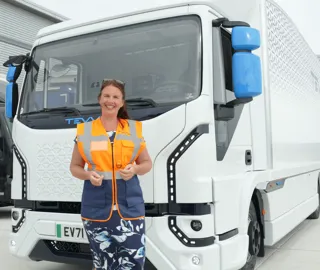Matthew Davock, director of commercial vehicles at Cox Automotive
According to figures from Manheim, the UK market for new light commercial vehicles (LCVs) declined for the sixth consecutive month in June, registering a drop of 23.0% to 20,449 units.
These numbers paint a picture of a challenging first half of the year for the sector.
144,384 new vans, pickups and 4x4s were registered in the first half of 2022, down by almost a quarter (24.6%) compared with the same period in 2021, amid ongoing global supply chain shortages.
Component shortages continue to hit production
A fair H1 year-on-year (YoY) comparison with 2021 is challenging, given the unprecedented circumstances we saw last year in which pent-up demand for online delivery vehicles and a bounceback in the construction sector combined for a record start to the year.
While overall demand in 2022 has largely been robust, component shortages have impacted deliveries and lead times, with the market remaining 26.5% below pre-pandemic levels.
The severe global shortage of semiconductors has resulted in supply constraints and longer lead times for commercial vehicles.
New battery electric vans gain momentum
Despite the ongoing supply challenges, growth in battery electric vans (BEVs) remained on a positive track, with 8,100 units registered in H1 2022, a 60% increase on the same period in 2021.
A large, improved choice of electric van models and derivatives are reaching the market this year, as many manufacturers prioritise production of their latest, greenest vehicles to meet growing demand from operators targeting running cost and efficiency savings.
While there is clear cause for positivity, the reality is that BEV LCVs still only account for one-in-13 new van registrations this year.
With ambitious zero-emissions regulations coming into effect in 2024 and 2030, greater urgency is required to boost consumer confidence at sufficient speed and scale to support a successful transition.
It is vital that charging infrastructure around the UK is developed to accommodate future demand. Incentives for electric van buyers should also remain in place to stimulate further growth.
Used LCV market figures paint a more positive picture
The first half of 2022 in the LCV marketplace has had a very different feel to it, as illustrated by our YoY market comparison statistics.
The record-breaking acceleration and prices we witnessed throughout 2021 were unlikely to continue, and since the start of the year we have seen used van prices realign to the new market, but still strengthening slightly.
The average H1 selling price for used vans at Manheim UK stands at £10,054, with average age and mileage figures of 64 months and 85,748 miles recorded, respectively.
This translates into positive headlines, with vans for the first six months making on average £418 more than the same period in 2021.
This is despite vans today being, on average, four months older, and registering 12,600 more miles on average than in the corresponding period, as more “pandemic worn” vans have entered our auction sites and halls.
However, these performance headlines do not necessarily reveal the whole picture, since overall used vehicle buyer demand and retail activity are significantly lower than 2021 levels.
Our first-time conversion rate of 67%, down from 82% last year, is also quite revealing.
Clear signs of buyer caution, as supply rises YoY
With the cost of living crisis, surging fuel prices and concerns around a lack of financial support incentives dominating the UK headlines today, it is no surprise this is having a knock-on effect and impacting both consumer and business confidence for used LCV stock.
Many van retailers have continued to report extremely slow retail conditions over the past 6 months and from this stock purchasing caution, frugality traits have been certainly evident.
Another important factor dominating the used LCV marketplace is the increased number of used vans being advertised in the UK today, with over 46,000 vans being advertised from a retail perspective alone.
This number is 32% higher than in the same period in 2021 and stems from greater choice and availability within the used LCV market.
The average advertised retail price of used vans has reached unprecedented levels, with only 15% of vans advertised priced below £10,000, while 62% are on the market for £15,000 or above.
On the whole, we expect the overall market to remain robust during the summer period as the new van supply headlines generally support the used market supply/demand dynamics.
That said, overall business and consumer confidence does need to show some signs of improvement if the used van market is to continue to ride this wave of positivity.
> Interested in comparing electric vehicle data? Check out our EV tool.
> Interested in ensuring the efficient use of EVs. Check out our dedicated editorial sections: Insight & policy | EV news | Charging & infrastructure | Costs & incentives | Benefit-in-kind | EV case studies | EV road tests





















Login to comment
Comments
No comments have been made yet.